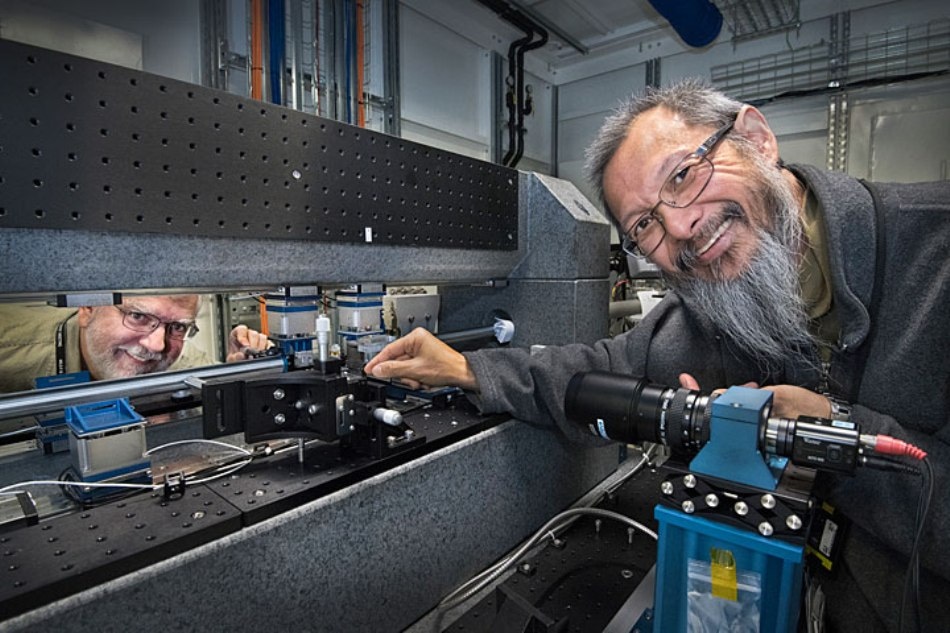Nov 20 2018
The invisible is made visible by the microscopes. Moreover, in comparison with the traditional light microscopes, transmission X-ray microscopes (TXM) can view through samples with considerably higher resolution, exhibiting extraordinary details. TXM is used by scientists across an extensive range of scientific domains to view the structural and chemical makeup of their samples ranging from biological cells to energy storage materials.
 NSLS-II scientists Scott Coburn (left) and Wah-Keat Lee (right) are shown at the Full Field X-ray Imaging beamline, where scientists and engineers have built a transmission X-ray microscope that can image samples 10 times faster than previously possible. (Image credit: Brookhaven National Laboratory)
NSLS-II scientists Scott Coburn (left) and Wah-Keat Lee (right) are shown at the Full Field X-ray Imaging beamline, where scientists and engineers have built a transmission X-ray microscope that can image samples 10 times faster than previously possible. (Image credit: Brookhaven National Laboratory)
Currently, researchers at the National Synchrotron Light Source II (NSLS-II)—a U.S. Department of Energy (DOE) Office of Science User Facility at DOE’s Brookhaven National Laboratory—have created a TXM with the ability to image samples 10 times faster than was possible earlier. The study has been reported in Applied Physics Letters.
“We have significantly improved the speed of X-ray microscopy experiments,” stated Wah-Keat Lee, lead scientist at NSLS-II’s Full Field X-ray Imaging (FXI) beamline, where the microscope was developed. At FXI, Lee and his team members decreased the time taken by a TXM to image samples in 3D from more than 10 minutes to just 1 minute, while still forming images with excellent 3D resolution below 50 nm, or 50 billionths of a meter. “This breakthrough will enable scientists to visualize their samples much faster at FXI than at similar instruments around the world,” stated Lee. A faster TXM can not only decrease the time it takes to complete an experiment but can also gather more valuable data from samples.
The holy grail of almost all imaging techniques is to be able to see a sample in 3D and in real time. The speed of these experiments is relevant because we want to observe changes that happen quickly. There are many structural and chemical changes that happen on different time scales, so a faster instrument can see a lot more. For example, we have the ability to track how corrosion happens in a material, or how well various parts of a battery are performing.
Wah-Keat Lee, Lead Scientist, Full Field X-ray Imaging (FXI) beamline, NSLS-II
In order to provide these capabilities at FXI, the researchers had to construct a TXM using the most recent developments in sensing (a method of tracking sample movement), ultrafast nano-positioning (a method of moving a sample while limiting vibrations), and control. Through a joint effort between the beamline staff, engineers, and research and development teams at NSLS-II, the new microscope was developed in-house at Brookhaven Lab.
According to the researchers, developing superfast capabilities at FXI also strongly relied on the sophisticated design of NSLS-II.
Our ability to make FXI more than 10 times faster than any other instrument in the world is also due to the powerful X-ray source at NSLS-II. At NSLS-II, we have devices called damping wigglers, which are used to achieve the very small electron beams for the facility. Fortunately for us, these devices also produce a very large number of X-rays. The amount of these powerful X-rays directly relates to the speed of our experiments.
Wah-Keat Lee, Lead Scientist, Full Field X-ray Imaging (FXI) beamline, NSLS-II
The researchers used the new capabilities at FXI to image the growth of silver dendrites on a sliver of copper. In just 1 minute, the beamline captured 1060 2D images of the sample and reconstructed them to create a 3D snapshot of the reaction. The researchers were able to produce a minute-by-minute, 3D animation of the chemical reaction by performing this again and again.
We chose to image this reaction because it demonstrates the power of FXI. The reaction is well-known, but it has never been visualized in 3D with such a fast acquisition time. In addition, our spatial resolution is 30 to 50 times finer than optical microscopy used in the past.
Mingyuan Ge, Research Lead Author and Scientist, NSLS-II
As this study nears completion, FXI has started its general user operations, inviting researchers from all over the world to use the beamline’s advanced capabilities.